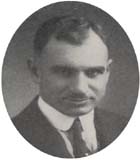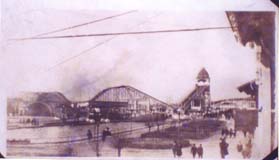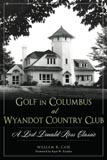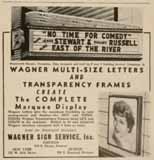The Zimmerman Family & the Olympic Swim Club
Wednesday, June 1st, 2016
Libby Wetherholt recently gave this presentation about the Zimmerman family to the Clintonville Historical Society, and has kindly agreed to share it with us.

Libby Wetherholt recently gave this presentation about the Zimmerman family to the Clintonville Historical Society, and has kindly agreed to share it with us.
Ron Irick recently alerted me to the Historic Marker Data Base. In it are photographs of several additional markers covering Clintonville’s notable people, places and events. The database includes the marker for Rand Hollenback, on Hollenback Drive at Whetstone Park, the Nat’l Register of Historic Places marker for East North Broadway Historic District, and the marker (currently in Powell) for the Grand Carousel which was formerly at Olentangy Olentangy Park.
Ron recently posted the Clinton Township/Clintonville Historic Marker.
Though not in this database, there is also a marker for the Old Beechwold Historical District. I believe there is also some sort of marker for the former home of the Republican Glee Club at 57 Weber Road.
Carousel expert and author Eric Pahlke recently emailed me with a question. The question is about the Grand Carousel that currently operates at the Columbus Zoo & Aquarium.
Eric is trying to resolve some conflicting information about the history of the carousel. He writes,
The oft-repeated story is that the carousel came to Olentangy Park in 1914, and was moved to Scioto Ranch Park in 1937-38 after Olentangy closed. Scioto later became Zoo Park, which became Wyandot Lake Park, which is now a combination of Zoombezi Bay and Jungle Jack’s Landing. I have a source that says the city of Columbus bought the carousel in 1981. The carousel apparently operated at Wyandot Lake until 1999 and has been running at the Zoo since 2000.
The problem is that I have some photographic evidence that says the carousel started on Coney Island and didn’t come to Ohio until the mid-1920s. This alternative story doesn’t distinguish between the carousel then coming to Olentangy Park and then to Scioto, or directly to Scioto.
I’m hoping that someone has materials in their archives that would help solve this dilemma. The primary question is whether the carousel came to Olentangy Park in 1914 or sometime in the 1920s. After that is solved, the other issues probably follow.
Does anyone have any information that could shed light on the issue? Eric is the author of Treasures from the Golden Age: West Coast Carousels, and Treasures from the Golden Age: East Coast Carousels.
 From Unforgettable Columbus, volume 2: “Although Herb Bash is not considered a pro, he did give lessons and was considered a pretty fair golfer. [Early on, he leased Indian Springs Golf Course.] In 1948 he opened a unique golfing complex on W. Dodridge St. between Olentangy River and the Olentangy River Rd. These 60 acres consisted of an 18-hole golf course and a large driving range. He sold the land in 1962 to Chemical Abstracts and moved his entire operation to just beyond Rte 161 on Dublin Road…The driving range on Dodridge was a place where many a Columbus duffer sharpened his game. Bash died in 1979 at the age of 86.”
From Unforgettable Columbus, volume 2: “Although Herb Bash is not considered a pro, he did give lessons and was considered a pretty fair golfer. [Early on, he leased Indian Springs Golf Course.] In 1948 he opened a unique golfing complex on W. Dodridge St. between Olentangy River and the Olentangy River Rd. These 60 acres consisted of an 18-hole golf course and a large driving range. He sold the land in 1962 to Chemical Abstracts and moved his entire operation to just beyond Rte 161 on Dublin Road…The driving range on Dodridge was a place where many a Columbus duffer sharpened his game. Bash died in 1979 at the age of 86.”
According to Bill Case’s web site, “former South High coach Herb Bash … made his living in the golf industry. Herb and his wife owned the Berwick Golf Course, a public facility located on the city’s southeast side. Herb helped grow the game at Berwick by conducting numerous golf clinics for the city’s youths. Shortly after joining The Elks’ in 1928, Bash, in partnership with Bugs Raymond, opened another golf course- Indian Springs, opposite Henderson Road on the east side of High Street. Herb later added the “Bash Driving Range” in Dublin to his collection of entrepreneurial golf activities. Like many of his compatriots at Elks’-Wyandot, Herb Bash could golf his ball. Prior to joining The Elks’, he won Dublin Road’s club championship. Herb was also a mainstay of the 1932 Wyandot golf team which won the inter-club championship.” [Image courtesy of Bill Case.]
 I never tire of seeing old images of Clinton- ville. Collector Galen Gonser shared these 1920 images with us. Admittedly they are taken with a simple box camera, but still, what’s not to like? (Photos courtesy of Galen Gonser.)
I never tire of seeing old images of Clinton- ville. Collector Galen Gonser shared these 1920 images with us. Admittedly they are taken with a simple box camera, but still, what’s not to like? (Photos courtesy of Galen Gonser.)
The first image below is Chute the Chutes at Olentangy Park.
We don’t know who these gentlemen are.
These images are taken looking north from Dodridge Bridge up the Olentangy River toward Olentangy Park–the second of the pair is a close-up.
For additional photos, search “Olentangy Park” on this web site.
 William R. Case has published a book about the Elks / Wyandot Golf Course. The book’s title is Golf in Columbus at Wyandot Country Club. As of this posting, The Book Loft in German Village (Columbus, OH) or Barnes and Noble at Easton Town Center have it in stock. If, like me, you are a prolific library user, you can also locate the book in a library near you here.
William R. Case has published a book about the Elks / Wyandot Golf Course. The book’s title is Golf in Columbus at Wyandot Country Club. As of this posting, The Book Loft in German Village (Columbus, OH) or Barnes and Noble at Easton Town Center have it in stock. If, like me, you are a prolific library user, you can also locate the book in a library near you here.
Bill has collected lots of great photos and researched this golf course (now the location of the Ohio State School for the Blind and the Ohio School for the Deaf) extensively. You will enjoy his book! [Images courtesy of Bill Case]
 This is an ad that just happens to show the signage of the old Beechwold Theatre at 4250 N. High (aka Camelot North and Drexel North, and currently an athletic club).
This is an ad that just happens to show the signage of the old Beechwold Theatre at 4250 N. High (aka Camelot North and Drexel North, and currently an athletic club).
The theatre was built by the F & Y Building Service (aka F & Y Construction Company). Mark Fontana informs me that the “Y” in this name is Yassenoff, and the first manager of the Beechwold Theatre was Milton Yassenoff, adopted son of Leo Yassenoff.
If anyone out there is aware of the whereabouts of blueprints, construction photos and high-res b/w photos of the finished theater, please let us know! The ad was shared with me by Mark Fontana, former manager of the Drexel North (aka Camelot North and Beechwold Theater) Mark is a collector. In another place on this web site I link to his web site.
 Bill Case has done a wonderful job of researching and writing the history of Donald Ross’ design of the Elks/Wyandot County Club. Check out his web site here. It’s a work in progress so check Bill’s site frequently.
Bill Case has done a wonderful job of researching and writing the history of Donald Ross’ design of the Elks/Wyandot County Club. Check out his web site here. It’s a work in progress so check Bill’s site frequently.
The first picture (to the left) is, of course, Donald Ross. In the left-hand image below, Harold J. Kaufman, John W. Kaufman, Arthur Shannon, Donald Ross, and J.V. Taylor peruse a topo map. The right-hand image below is the 5th hole–308 yards–par 4. See Bill’s web site for the history and for more image gems.
(Images courtesy of Bill Case and Betty Huber)